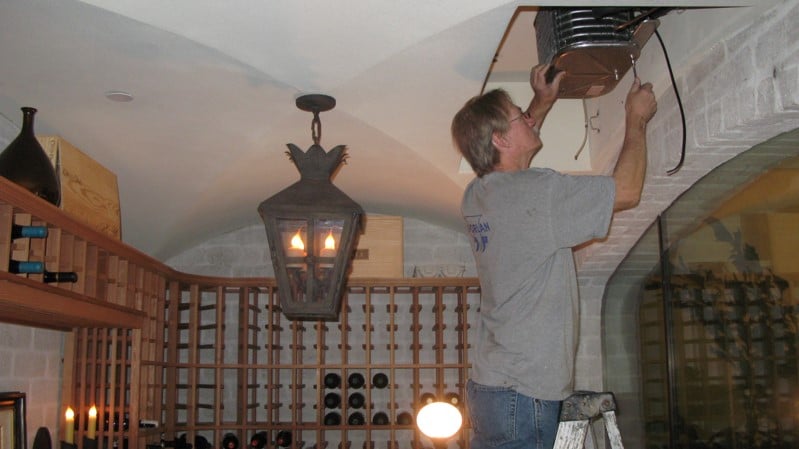
Centuries or decades-old wine cellars last a long time because of this crucial fact: they’re maintained with the right wine cellar refrigeration system and sealed with the right amount of insulation.
Learn the key to long-lasting wine cellars: the right wine cellar refrigeration system and insulation! Discover how to select the perfect cooling unit for your home or commercial wine cellar, and explore the three major types of wine cellar cooling systems.
Learning how to create a sanctuary for your wine collection can be a tedious venture to do, but ensuring optimal preservation can unleash the true flavor of your wine even for decades!
How to Determine the Right Wine Cellar Refrigeration System for Your Cellar
There are many factors to be considered in order to determine which wine cellar refrigeration system is best for your wine storage room. The best way to find out is through these steps:
1. Room Size and Capacity
The first thing to do is know the size of your wine storage room. Accurately measure the size of your residential or commercial wine cellar in cubic feet. The cooling unit should be able to handle the volume of your cellar space. Consider the cubic footage of the room and the type of insulation on the walls.
If the room or space you are converting into a wine cellar is irregularly-shaped like under the stairs, take at least 3 measurements vertical and horizontal (both ends and one at the center).
2. Location
Determine whether you have a climate controlled room adjacent to your custom wine cellar. The room should be the same size or larger than your wine storage room for you to be able to use a through-the-wall wine cellar cooling system. Keep in mind that all types of through-the-wall units produce heat and lots of noise into the adjacent room. If you do not like this, you may choose from the ducted or split system options.
If your wine cellar is directly beside an external wall, you may have to choose a more powerful cooling unit and a split-type.
3. Cooling System Type
There are various cooling system types available, including self-contained, ducted, split, and through-the-wall units. Each has its own advantages and installation requirements. Assess your cellar layout and preferences to decide which type suits your needs best.
Note: It really varies from one situation to another. Some may need through-the-wall refrigeration unit for inside application or for outside application. Some may need a split wine cellar cooling system or a ducted wine cellar cooling system Ducted systems also come in different kinds. Some allow ducting for cold air, others for hot air, while some may allow both.
4. Temperature and Humidity Control
Wine requires specific temperature and humidity levels for optimal storage. Look for a cooling unit that offers precise temperature control within the desired range (typically between 50°F and 59°F) and humidity control (around 60-70%). Some units have built-in humidity control features.
5. Noise Level
Consider the noise level of the cooling unit, especially if your wine cellar is located near living areas or if excessive noise is a concern for you. Look for units that operate quietly or have noise-reducing features.
6. Ventilation Requirements
Cooling units require proper ventilation to dissipate heat generated during operation. Ensure that you have appropriate ventilation options available, such as sufficient space around the unit, proper ductwork, or a dedicated exhaust system if required.
7. Energy Efficiency
Look for energy-efficient cooling units that consume less power, helping you save on electricity bills in the long run. Energy Star-rated units are a good option to consider.
8. Reliability and Maintenance
Choose a cooling unit from a reputable manufacturer known for reliability and longevity. Check the warranty terms and available customer support. Additionally, consider the ease of maintenance and access to replacement parts if needed. While you can perform basic maintenance works for refrigerated wine cellars yourself, it is recommended to contact a professional.
9. Budget
Set a budget for your wine cellar cooling unit. Prices can vary based on capacity, features, and brand. Consider the long-term investment and choose a unit that fits within your budget while meeting your requirements.
10. Professional Installation
Depending on the complexity of the cooling unit and your technical skills, professional installation may be necessary. Improper installation can lead to inefficient cooling or damage to your wine cellar. Consult with experts or hire professionals to ensure correct installation.
11. Research and Reviews
Read product reviews and gather information from reliable sources, such as wine cellar experts, retailers, or online forums, to gain insights into different cooling unit options. This will help you make an informed decision.
The 3 Basic Custom Wine Cellar Refrigeration System Types

1. Through-the-wall Wine Cellar Refrigeration Units or Self-Contained Systems
Through-the-wall systems, also known as self-contained systems, are the most simplistic among the 3 types of wine cellar refrigeration. They are simply mounted through a hole in the wall of the custom wine cellar in California. The front end of the unit blows cold air into the storage, room while the back end exhausts warm air out. This type is one the least expensive types of wine cellar cooling systems and is very easy to install.
2. Ducted Wine Cellar Cooling Units
3. Split Wine Cellar Refrigeration Systems
The setup of split cellar cooling systems is similar to that of central air conditioning. The evaporator of the refrigeration system is located inside or close to the wine cellar while the condenser is located elsewhere. The two parts are connected through a line set. This kind of system is costly and you need a licensed HVAC professional to install the system.







